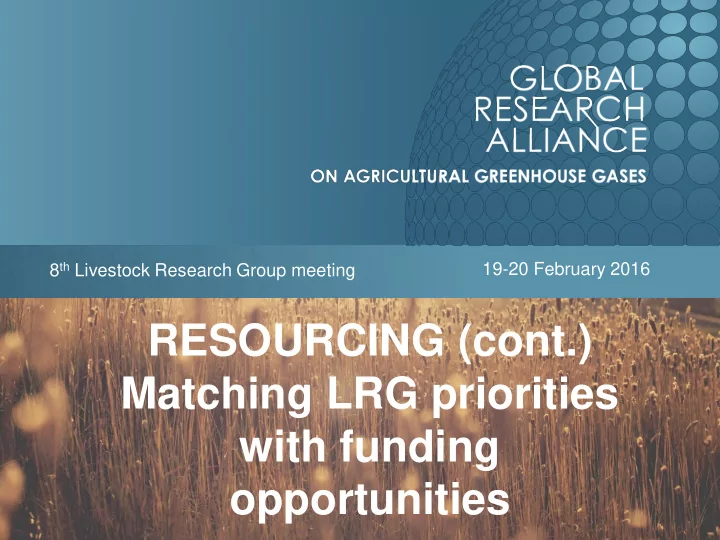

8 th Livestock Research Group meeting 19-20 February 2016 RESOURCING (cont.) Matching LRG priorities with funding opportunities
Resourcing: overview Day 2: 8.40am-10am • Report-back from Network Coordinators • Discuss next steps in terms of developing potential proposals, ERA-GAS bids, accessing other funding opportunities, involving more countries
REPORT BACK FROM NETWORK COORDINATORS
Animal Health Network • Need to consider sub-acute (silent) as well as epidemic disease. • A search for diagnostic “tools” (? Greenfeed; SCC?) • SUSAN is probably a better fit than ERA GAS for AHN. • We need (and currently Lack) a compelling research proposition
Livestock Animal Health Network (cont.) • Both cause and are affected climate change. • The best way to combat this for livestock and their owners is to improve the productivity of animals (more milk, more meat). • To do this we first need to better understand the way farmers manage their livestock at present. • We need to know about how they grow, what they are fed, when they have babies and how much milk they produce.
Animal Selection, Genetics and Genomics Network Melbourne, Australia February 20 th , 2016
Reflection break-out sessions Best breeding practices from climate smart angle – Trade offs between traits Great need for biological understanding of heritability -> where does it come from? – E.g. energy in, energy out, where does energy go? For developing countries the focus is on adaptation of local breeds to higher production – Learn from other countries; avoid making same mistakes, and inventing wheels twice
Reflection break-out sessions Breeding goals worldwide – what are aspirations of farmers across different production systems? – New traits (=> recording schemes!) • Temperament, stature, etc. Need for meta-dataset – also across disciplines Suggested proposals 1. Social economic study on breeding goals 2. Repeated trials in different production systems
THANK YOU!
Feed and Nutrition Network Suggestions for ERA-GAS proposal – Explore feed-nutrition-manure-soil C/N emissions relationships (in particular microbial activity related) • Nutrition and manure management practices in relation to GHG emissions • Current accounting of these components, and ways to integrate them; modeling to improve this • Soil C sequestration (of manure C; soil management) • Development of ‘functional’ meta -analysis of data-bases – Identify gaps in knowledge and propose improvement of estimates (of rumen, manure and soil emission inhibitors) – Evaluate inventory methodology on fate of feed, excreta and manure C & N – How mitigation practices are going to be implemented – economics of implementation, benefits/costs to farmers, tradeoffs – Whole-farm approach; variety in climatic regions & farming types/conditions/practices; evaluate universality of current knowledge – Link activities to the current projects, such as FACCE JPI GLOBAL NETWORK, and EU-MACSUR, AgMIP, etc., and keep linkage with LRG- network groups – Project structure: core FNN project team, open to participation and involvement of e.g. non-funded members
Manure Management Network Improve visibility of network Work together with the FNN Why: Analyse N excretion and not just CH4 for dietary additives Feed composition for specific N content in dung and urine Manure is a resource – not necessary for it to be poor in N How: Bilateral network meetings Network coordinators should exchange information Presence of one or more scientist from another network present at network meetings Study inhibitors throughout the whole animal-manure continuum Data base of emission factors, methods, guidelines Use Harvard dataverse Review IPCC excretion factors Proposed solutions must be economically viable for farmers
Rumen Microbial Genomics Network • White paper on priorities – workshop In June 2016, INRA-Rowtt workshop, metagene • Meta database • Guidelines and tools for interrogation • Reference manual on culturing techniques
Recommend
More recommend